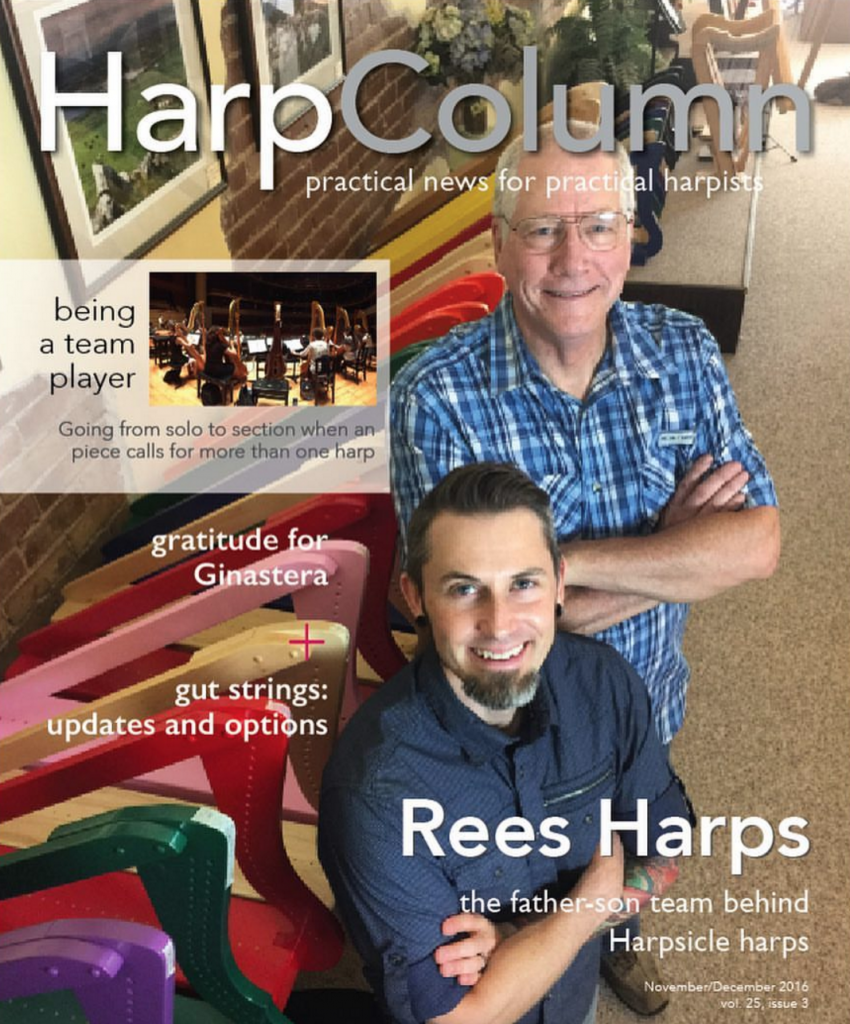—by Yolanda Kondonassis

Alberto Ginastera (pronounced with a soft “G” sound) wrote over 100 compositions in his lifetime, including operas, ballets, orchestral works, concertos, instrumental pieces, and film music. Much has been said this year about Ginastera’s work, as the music world marks his centennial. By any measure, he played an important role in the contemporary music movement of the 20th Century. But for harpists, he did much more than that. He wrote our piece.
Written between 1956 and 1965 (and premiered in 1965 after two postponements), Ginastera’s Harp Concerto, op. 25, came into the world with a slightly bumpy passage. Both Ginastera’s busy schedule and the sheer difficulty of writing well for the harp stalled the concerto’s progress more than once. Edna Phillips, principal harpist of the Philadelphia Orchestra from 1930 to 1946, commissioned the concerto as one of many new compositions for the harp that she initiated during her career, but she had retired by the time the work was completed. Because of this, solo harpist Nicanor Zabaleta premiered the concerto with the Philadelphia Orchestra almost a decade after its commission. It was a perfect time for such a groundbreaking work to make its debut. American society was changing in the mid-1960s, and minds were opening to reconsider societal norms in civil rights, gender equality, music, and beyond.

I have long made the comparison between the evolution of the harp—an instrument often considered to be possessed of undeniable feminine qualities—and the progress of feminism, both in cultural treatment and common perception. For women and for the harp, the winds of change really began to stir in the mid-20th century as images and opportunities began to expand. Ginastera’s Harp Concerto was the right piece, at the right time, in the right place.
I first saw a copy of the concerto at the Salzedo House in Camden, Maine, during the summer of 1973. Liberally marked with neat, red pedal changes and complex-looking fingerings in black pencil, I flipped through it and thought how different it looked from most of the music I knew. The configurations of notes and patterns on the page looked angular and modern to my 10-year-old eyes. It scared me, but I couldn’t wait to start learning it.
In retrospect, the first thing about Ginastera’s Harp Concerto that excited me was that it looked like piano music, which had been my world for many years before I began playing the harp—and I must admit it was not the harp, but the piano that was my first love. I was drawn to the power, the control, and the limitless possibility of the piano—not to mention the music of composers like Bartok, Shostakovich, and Scriabin.
…I flipped through it and thought how different it looked from most of the music I knew. The configurations of notes and patterns on the page looked angular and modern to my 10-year-old eyes.
I began studying the harp when I was 9, and I liked it right from the start. It came pretty easily to me after all the years of piano training. But to tell you the truth, learning to play the harp was my mom’s idea. As a kid growing up in Oklahoma, I was somewhat of a tomboy. What better way to quell the wild potential of a budding cowgirl than to soothe those tendencies with the heavenly strains of harp music? As often happens when the best intentions of moms are concerned, the idea didn’t quite achieve its goal (of taming me, that is), but it did change my destiny somewhat. “I’d play the harp,” I remember saying to myself, “but I would try and do it my way.” Ginastera’s concerto was the first thing I saw and heard at that formative age that made me think, “Maybe I can.”
As a high school student at Interlochen Arts Academy, I spent countless hours in my basement practice room getting to know Alberto Ginastera through his music—so much so that it began to feel like I really knew him. He became more than just a composer to me; his music felt like a pathway and, in many ways, a voice. His complicated technical configurations fit my large hands, and his beautiful yet stark phrases spoke to me personally. There was something in his angst that matched my own.
At approximately the same time as I was living inside his Harp Concerto during my high school years at Interlochen, Ginastera was writing his huge orchestral work, Popol Vuh, inspired by the genesis of creation. It was the early 1980s and the composer was a resident of Geneva, Switzerland, after leaving his native Argentina to seek greater artistic freedom. Popol Vuh is a powerful work that deals in all the elements that I love about his music in a heightened, almost magnified way—as if he had only one more chance to say what he needed to say. He died before completing Popol Vuh, but he managed to write passionately about the beginning of life while living the last few months of his own.
Last January, I had the rare privilege of spending an evening with Ginastera’s daughter, Georgina. We talked for over two hours, and I asked her everything I’d ever wanted to know. What made him laugh? What was his favorite color? His favorite food? What made him sad? What frustrated him? What motivated him? What inspired him? What did he consider his greatest accomplishment in life? Georgina was warm, funny, and one of those people you never forget. At the end of our time together, she said to me, “You know, I have the feeling that a lot of what I’ve told you tonight only confirms what you had already imagined. You have lived in his spirit.” I couldn’t quite answer because the words caught in my throat, but somehow she knew. His music was my first real voice at the harp, and his spirit had played a big part in freeing mine.
Happy 100th birthday, Mr. Ginastera. I thank you. •






